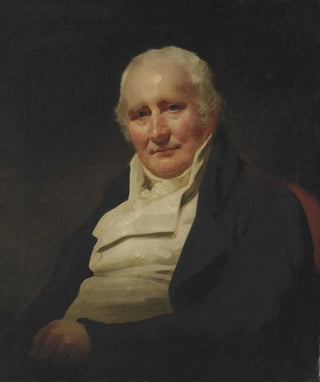Art print | Portrait of M. Spottiswood - Sir Henry Raeburn


View from behind

Frame (optional)
Portrait of Mr. Spottiswood - Sir Henry Raeburn – Engaging Introduction
In the vast panorama of art history, certain works transcend the simple frame of painting to become witnesses of an era, reflections of society, and portraits of the human soul. "Portrait of Mr. Spottiswood" by Sir Henry Raeburn fits perfectly within this tradition. Created in the early 19th century, this painting does not merely capture the appearance of a man but also evokes an atmosphere, a personality, and a specific moment in Scottish history. Through this work, Raeburn invites us to delve into the life of Mr. Spottiswood, a man whose gaze, both thoughtful and determined, seems to tell his personal story while connecting us to a broader social context.
Style and uniqueness of the work
Sir Henry Raeburn's style is undeniably marked by his realistic approach, characterized by finesse in rendering textures and particular attention to detail. In the "Portrait of Mr. Spottiswood," the artist uses play of light and shadow to bring his subject to life. The drapery of Mr. Spottiswood's costume is painted with such precision that it almost feels tangible, while the delicacy of the face, with its expressive features, reveals rare psychological depth. This painting is also distinguished by a dark background that emphasizes the presence of the character, placing him at the center of attention. Raeburn thus manages to create an intimate atmosphere, where the viewer is invited to contemplate not only the appearance of Mr. Spottiswood but also the emotions emanating from his expression.
The artist and his influence
Sir Henry Raeburn, an emblematic figure of Scottish painting, knew how to combine tradition and innovation throughout his career. As a portrait artist, he captured the essence of his contemporaries with a sensitivity unique to him. Mastery of chiaroscuro technique and his talent for representing the nuances of human personality made him an essential artist of his time. Raeburn influenced many artists who followed in his footsteps, notably in Scotland, where he helped establish

Matte finish

View from behind

Frame (optional)
Portrait of Mr. Spottiswood - Sir Henry Raeburn – Engaging Introduction
In the vast panorama of art history, certain works transcend the simple frame of painting to become witnesses of an era, reflections of society, and portraits of the human soul. "Portrait of Mr. Spottiswood" by Sir Henry Raeburn fits perfectly within this tradition. Created in the early 19th century, this painting does not merely capture the appearance of a man but also evokes an atmosphere, a personality, and a specific moment in Scottish history. Through this work, Raeburn invites us to delve into the life of Mr. Spottiswood, a man whose gaze, both thoughtful and determined, seems to tell his personal story while connecting us to a broader social context.
Style and uniqueness of the work
Sir Henry Raeburn's style is undeniably marked by his realistic approach, characterized by finesse in rendering textures and particular attention to detail. In the "Portrait of Mr. Spottiswood," the artist uses play of light and shadow to bring his subject to life. The drapery of Mr. Spottiswood's costume is painted with such precision that it almost feels tangible, while the delicacy of the face, with its expressive features, reveals rare psychological depth. This painting is also distinguished by a dark background that emphasizes the presence of the character, placing him at the center of attention. Raeburn thus manages to create an intimate atmosphere, where the viewer is invited to contemplate not only the appearance of Mr. Spottiswood but also the emotions emanating from his expression.
The artist and his influence
Sir Henry Raeburn, an emblematic figure of Scottish painting, knew how to combine tradition and innovation throughout his career. As a portrait artist, he captured the essence of his contemporaries with a sensitivity unique to him. Mastery of chiaroscuro technique and his talent for representing the nuances of human personality made him an essential artist of his time. Raeburn influenced many artists who followed in his footsteps, notably in Scotland, where he helped establish






